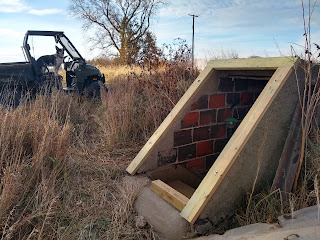The Green Door
The Farm Report11-15-2022
 |
From that to this. I'm risking breaking my arm patting myself on the back, but I think the new door came out pretty good. We'll need to pour a new concrete stoop next spring. |
 |
After some judicious digging and fitting, we put in the stainless tube. It is about twice as long as what you can see. We poured ordinary dry builder's sand around it to seat it in place. |
 |
I used a Vice Grip pliers to hold the bolt shaft while I turned the old nut off. |
 |
Here is the first set of plates down and tight. |
 |
Same shot, with the new top plate flipped over and in place hiding the anchor bolts - and protecting them from weather. Always test fit your work before you apply glue! |
 |
Skin on, and Annie was ready for the end of the day. |
 |
The season has closed in for sure now. These are my Gypsy broccoli plants. |
 |
"This isn't going good, Tim!" |
 |
"He's sticking his paw out at me!" |





















I'm sure there's no way your new, refurbished, old cellar won't last for another 120 years! When you do a project you do it right. Thanks for documenting it for us. A picture IS worth a thousand words. (Although we bloggers can't help but using those thousand words at times!) Don't you think you should get Annie a pup of her own? One that would bond with her and enjoy a nice cuddle-up now and then? Would be a lot easier than trying to be friends with a persnickety cat!
ReplyDeleteI'm glad you enjoyed following along. I like to 'get it right' the first time so I don't annoy myself with what I 'shoulda done' all the rest of the time afterwards. Having roofing metal scraps left over was just the icing on the cake for this project. Two Annie's at one time? Yikes! Annie is tons of fun, but she's a real handful too. Heelers are not 'warm and cuddly' dogs - but they are very affectionate and caring, albeit in their own pushy/bossy way. I think I'd better stay with just one at a time....
DeleteDrat. Don't know why blogger has been listing me as "Anonymous" lately. Above was me, Mama Pea. :o\
ReplyDeleteSure hope that cave is appreciated by another two-three generations as it should be! Michelle at Boulderneigh
ReplyDeleteThey say we plant trees for the next generation. Maybe keeping the cave intact will work out that way, too. Meanwhile I'm going to be doing my darnedest to make use of it for a long time myself! Cheers
DeleteCurious about your amaryllis bulbs. Do you peel them for storage? I grew Gypsy broccoli this year, and have been harvesting shoots every 2 to 3 days until they went limp with an heavy frost a few days ago. The stems were so thick, I used an axe to chop them as I didn't want to pull/dig them and disturb the soil under the mulch, now that it is frozen. This morning, we awoke to a white world...first snow of the season. Love that root cellar, super job! We are hopefully building one next summer.
ReplyDeleteI do not peel the amaryllis bulbs. I do wash them off with running water from a garden hose. The spent 'peels' wash away like dried onion skins. The remaining layers will 'reskin' for me. So, what you're seeing is just the new clean 'skin' layer. I've done this for years and years. Sometimes, I give them a dunk in some Lysol solution if I'm worried about disease issues. Otherwise, they're pretty bullet proof for me. Into the cold for a few weeks, then I'll repot and enjoy blooms in the house. Then, eventually they go back outside into the garden for the summer. They really don't seem to need much TLC. And yes! Gypsy just about needs an axe to remove them in the fall. It is a fantastic broccoli variety. Good luck on your root cellar project. They are so much worth the effort - and it is a lot of effort and expense! - but something that puts a big positive edge on your gardening and preserving slate.
DeleteYou do stellar work. The root cellar restoration is amazing. Your high winds are not going to move any part of this build. Annie is relentless in her desire to be OJ's friend. That said, she's reading OJ's signals pretty well and averted a clawed slap. Good girl!
ReplyDeleteHappy Thanksgiving! (I almost forgot...)
ReplyDeleteThanks for the Thanksgiving wishes! Same back to you and all. Annie is getting wiser - but she just can't leave O.J. alone. Annie reacts, O.J. plots. And thus it will ever be....
DeleteThat's a great job you've done there, I think they'd be proud you kept it goign rather than letting it fall down. I'd love a root cellar, maybe one day!
ReplyDelete